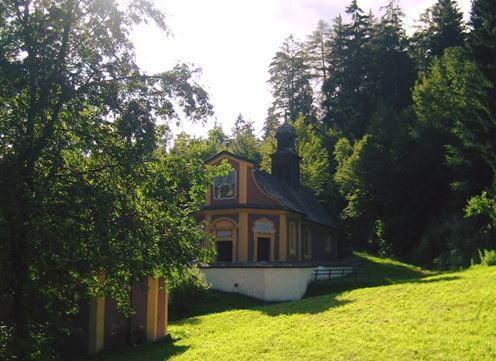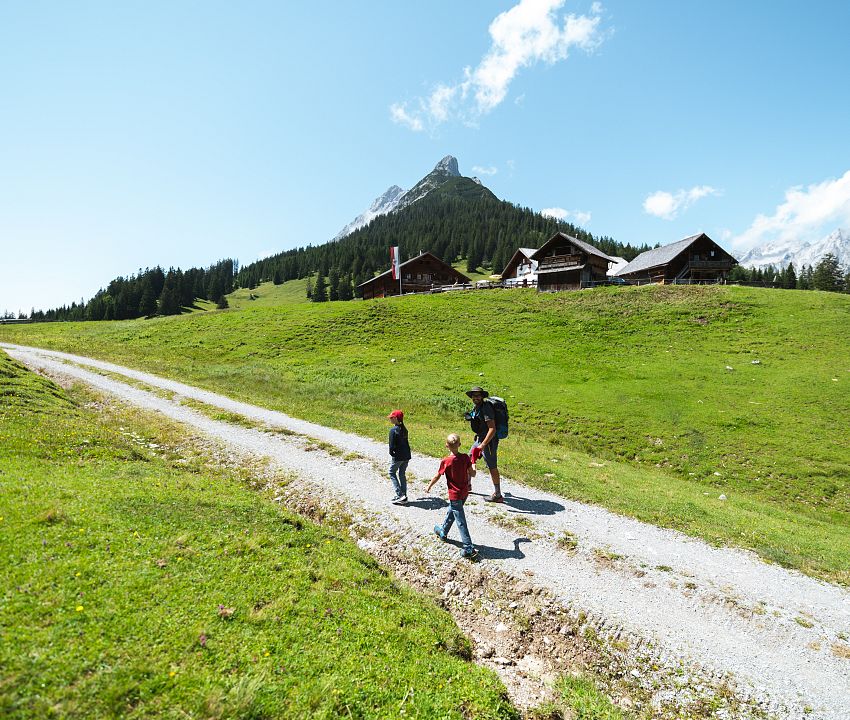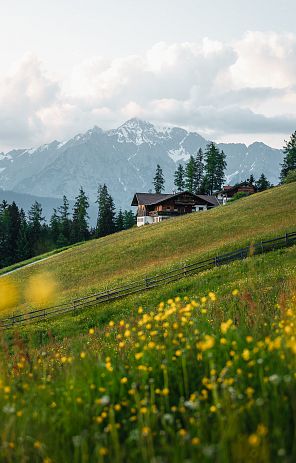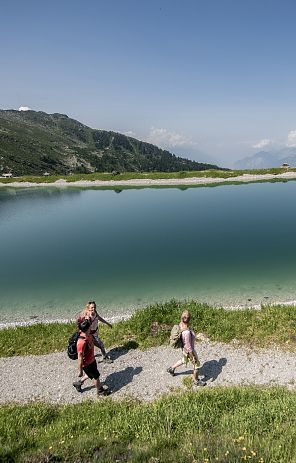Powerful Place. Maria Larch near Gnadenwald
Maria Larch is many things: first and foremost a wonderful 300-year-old place of power in the Hall-Wattens region. But Maria Larch is much more than that. It is a place of pilgrimage in the middle of the forest, away from busy villages or settlements. A forest path leads to this idyllic place between Gnadenwald and Terfens on the Gnadenwald plateau. The imposing Karwendel massif towers to the north, while to the south the hiking trail repeatedly offers magnificent views of the Inn Valley. The path to Maria Larch is also a well-known and much-traveled pilgrimage route: the Way of St. James. So it's no wonder that the Maria Larch pilgrimage church has been visited by numerous pilgrims since 1698.
And there is another important reason for the popularity of Maria Larch near Gnadenwald. The healing spring there, which gushes out of the baroque well house, is said to have cured the mute girl Maria Jenewein of her ailment in the 18th century. Since then, the water has been regarded as an invigorating drink. It is a right-turning water in a place of power that could not be more impressive. Many people come here to drink water. Out of respect, it is an unwritten law to make an offering, whatever it may be. Because this special place of power should be treated with reverence and gratitude.
The Maria Larch power place at a glance
- Pilgrimage chapel
- Well house with healing spring
- lies on the Tyrolean Way of St. James
- Maria Larch circular hiking trail
- the larch tree
- Karwendel Nature Park
The legend of Maria Larch
Magdalena Bogner, farmer of the Spieltennerhof farm in Schlögelsbach, was the initiator. On her way to Terfens, she always felt drawn to a particular larch tree and prayed there. When she informed the benefactor of St. Martin in Gnadenwald, Johann Weiß, of this in 1665, he himself made a statue of the Virgin Mary out of clay, which she was to attach to this larch tree. She brought the honorable gift home and her husband placed it in a niche by the designated larch tree. A narrow roof protected the image from falling rain and a narrow block was placed on the ground so that people could kneel more comfortably during prayer.
Soon other people were also worshipping at Maria-Lärch. Shortly afterwards, a wooden chapel was built, which was replaced by a stone one just a few years later. This was enlarged in 1718. From 1724, a hermitage was also connected to the little church. Joseph ll. abolished the pilgrimage and the cult object came to Terfens. The chapel was reopened in 1796 with the returned Virgin Mary. The little pilgrimage church was restored in the early 1990s and has become very well known in German-speaking countries.
The ensemble of Maria Larch
The place of power consists of an ensemble of three buildings: the pilgrimage church, the adjacent well house with the healing spring and the small apparition chapel a little further to the west - this is where the larch tree is said to have once stood.
The healing spring
Since the deaf-mute girl Maria Jenewein was cured of her ailment by the dextrorotatory water in 1718, countless people have made pilgrimages to Maria Larch to fill canisters, bottles and other containers with this special drinking water. Pilgrims even find their way to this place of power from Italy and Bavaria. In addition to its healing effect on the human body, there are many other myths surrounding this special water. Flowers are said to last longer and pond water is said to be free of algae. Even after many hours and days, the Maria Larch water does not taste stale, which is why many campers fill up their water supplies there before setting off on vacation. However, this has not been scientifically proven.
Even more miracles
There are also reports of a child who was constantly at the doctor's because of open feet, but there was no improvement. Until he bathed in the water of Maria Larch and got well. Or the pain-stricken man who sat down on a bench in front of the queue of people waiting in front of the fountain and whose agonizing pain in his legs got better after a short time. He had then regularly fetched water and was eventually free of pain.
It is irrelevant whether the water actually has a healing effect or whether faith alone is involved in these miracles: the fact that Maria Larch and its healing spring exude a special aura is undisputed. The many votive tablets and pictures bear witness to this and are listed in the Miracle Book, which is kept in the Terfens parish archives.
Even when the chapel was closed as a result of the Josephine reforms and the miraculous image was transferred to the parish church in Terfens, the faithful continued to pray to Our Lady. Instead of the miraculous image, a picture of the Virgin Mary was placed in the chapel. After the death of Emperor Joseph in 1790, all reforms were reversed and the pilgrimage site was ceremoniously reopened in 1796. Around a hundred years later, the image of the Virgin Mary was also transferred back to Maria Larch.
The larch
The tree is closer to man than we realize today: it stands upright, grows, fades, has its spring, autumn, winter and flowering season. The origins of all things and of existence lie in the roots.
The Celts and Germanic tribes have always appreciated this, which is why trees in particular had a special significance for them. But the Greeks and Romans also cultivated a certain tree worship. In Christianity, this worship was dismissed as paganism and banned.
The name Maria Larch is derived from "Maria Lärch" in the Gnadenwald forest. If you think back to the middle of the 17th century, you can imagine how dangerous it was to profess worship of nature, which was neither desired nor permitted by the omnipresent and powerful church. In those times, it was very easy to get the reputation of being a witch. Nevertheless, there were apparently people whose faith in trees was so deep that they remained unimpressed by the threats. The farmer's wife of the Spieltennerhof farm, Magdalena Bognerin, looked up to a large larch tree with love and reverence.
There were many such sacred trees in Tyrol, which enjoyed love and veneration in the popular consciousness. Many of the traditional pilgrimage sites can be traced back to a tree. Tree and spring go hand in hand. A mighty tree must necessarily grow near a spring, as it needs over a thousand liters of water a day to sustain itself. In the course of time, the veneration of the tree then became part of the cult of Mary or a saint. It is obvious that Marian legends cannot be linked to trees, at least not in the early phase of Christianity. The first Christians would have rejected the association of the holy family with a tree; any kind of tree worship was abhorrent to the Jewish prophets and was far too reminiscent of the pagan ideas of the Greeks and Romans. Wherever a Christianized tree legend has been handed down, one can assume that one is on the site of a pre-Christian sanctuary.
The fine and cheerful larch trees are the subject of countless legends and stories: They are the resting and dancing place of those forest fairies who show the lost person the way and are happy to assist any good person. This character made the larch one of the most popular medicinal plants of the past: in the Middle Ages, the resin was used for lung and urinary problems, as an ointment for wounds and as a plaster; it stimulates circulation, disinfects and expectorates. A resin ointment helps with rheumatic pain, lumbago and neuralgia, it draws out pus and accelerates healing. As a chest ointment, it is recommended for coughs and bronchitis; internal use depends on the dose and can be irritating or healing.
If you would like to find out more about medicinal plants, visit our Tyrolean medicinal herbs page!





